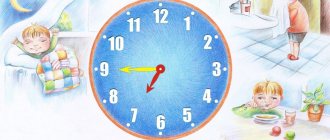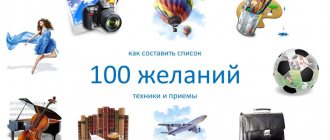An outline is a list of the main semantic blocks of the text. Drawing up an outline is of great importance when preparing a text. Points of the plan are guidelines that help the author move in the right direction - towards the task assigned to the text.
A text written without a plan resembles a stream of consciousness. It is impossible to grasp its central idea, and following the development of thought is extremely difficult. Such a text has the right to life in fiction, but in the field of business or science it is unacceptable. In this article we will look at the types of plans, analyze how to create a text plan, and analyze examples of plans.
What is a text outline and why is it needed?
An article outline is a list consisting of the main ideas of the article, which are presented in a logical sequence. The main task is to reveal the content. The ideal structure is one that, when you look at it, brings to mind the entire text.
Each item on the list is a guideline that helps you understand the essence of the article.
Why does a copywriter need to draw up and think through a plan:
- get rid of the mess in your head, sort all the information into shelves;
- make the material useful and exciting for the reader;
- thanks to a well-thought-out structure, the reader can easily find the block of information he needs;
- the number of clients and rave reviews will increase along with your income.
The ability to structure helps you prepare for exams and analyze competitors’ articles.
LeaderTask Scheduler
- Your data is always at hand
- Allows any rearrangement of tasks
- Transfer dates
- Planning for the day, week, month and more
- Reminders
- Creating any categories for the plan
- Tasks in Focus
- Tags: important, urgent, attention
- Color coding of tasks
- Deleting tasks
- Task completion status
- Transferring tasks with “Overdue” status
- Regular reminders
- Attaching files, links, images
- Additional changes
Making the structure correctly: detailed instructions
When you first sit down to write a plan, chaos usually begins in your head, and it’s difficult to identify the main idea. As a result, points that should be short are blown out into entire paragraphs.
For reference. The main idea is the task of the article/work, and the topic is the general name of the content.
Where to start and how to finish:
- Read the text 2 – 3 times. Take notes and write down ideas as you read. If you're writing from your head and don't need to study competitive articles, then skip this step.
- Ask yourself two questions: what is its topic, what is the material written for. This way you can immediately decide on the main idea.
- Take a closer look at each paragraph and think about where the key point is, what is its meaning? Often a paragraph is an already completed thought that can be included in the structure as a subheading. Don't dwell on the details. We are only interested in the action, the plot twist.
- Leave the list for a few minutes and relax. Re-read it. Do you understand what the work is about just by looking at it? Yes - you have worked well, no - you need to improve it.
- Copy the plan into a clean copy and use it for its intended purpose.
A few tips for the journey:
- Write down unfamiliar words and concepts that you will use separately. Be sure to clarify their meaning.
- Don't repeat yourself. If the same word comes up several times, replace it with a synonym.
- Don't be afraid of modifications. If, when you return to the list after a few minutes, you want to make changes, then do so.
- The text outline for a public speech should be short. One paragraph consists of a maximum of 2 – 3 words.
- Formulate paragraphs with numbers and subparagraphs with bulleted lists.
Keep a separate notebook for plans. Write down all your work there. This is a good source of inspiration that will help you keep track of your progress as you re-read it.
We took a look at the general way of structuring the article. Now let’s complicate the task and divide the plan into several types, each of which is created in a special way.
Another example of compilation
Let's choose a creative topic for the article - drawing portraits.
Heading:
How to learn to draw portraits and cartoons using the dry brush technique
If the plan is ready, but there is a problem with the title for the text, then here is an excellent article on writing titles, with templates and examples on my blog.
Introduction:
The ability to draw black and white and color portraits using the dry brush technique will allow you to earn big money. This article will tell you how to do this.
There is also a good article on introduction that will help you with this matter.
Content
- Drawing tools
- Where to buy special paper and paint
- Portrait sketch
- Drawing Techniques
- How to check for errors
- Where to find customers
- Useful tips
Conclusion:
Let's draw a conclusion about the benefits of the post:
What types of plans are there?
A plan helps us not to get confused, to clearly formulate and express our thoughts. There are many options. Now we will look at the most well-known methods.
Abstract
Each section is represented by a thesis. Thesis is a brief statement of the main idea of 1 – 3 paragraphs. Distinctive feature: many verbs. It consists of a subject, which names the topic, and a predicate, which reveals it. Without a predicate, the main idea is lost.
How to find a thesis statement? It is difficult for beginners to highlight the main thing, discarding the details. Sometimes the subtitle of the structure is stretched to 10–15 words, although this is unacceptable. Ask questions about the paragraphs. But remember: the answer should consist of 4 – 8 words and no more.
For example, I took the fairy tale about the goldfish by A. S. Pushkin:
- The older man lived poorly with his old lady.
- The old man caught the magic fish and released it.
- Starce told everything to the old woman, she demanded a trough.
- The dissatisfied old woman sent the old man to fetch the hut.
- The hut was not enough for the grumpy old woman; she wanted to become a queen.
- The old woman was tired of being a queen, she wanted to become the mistress of the sea.
- The fish could not bear the old woman's greed and disappeared.
- The old man and his wife were left with nothing.
Every 1,000 characters = 1 abstract. If you are writing a 6,000 character article, you need to highlight 6 points. This way you won’t overdo it with water in the text, the material will be pleasant to read.
Interrogative
This type of structure is based on questions to a semantic block of text. Personally, it’s easier for me to work through an article this way. Questions arise while studying materials and thinking about the topic.
This plan is ideal for informational articles, master classes, instructions, and analysis.
I will again show what it looks like using the example of a fairy tale about a goldfish:
- What did the old man do when he caught the magic fish for the first time?
- How did the old woman react to the story about the goldfish?
- What did the old woman make her husband ask the fish?
- How did the fish respond to the old woman's last wish?
- What happened to the old man and his wife at the end?
Ask questions using words: how, when, why, whose, how many, who. Avoid the interrogative “whether” part.
Nominative
The title plan consists of theses expressed by nouns and adjectives. No verbs needed. It's very short. The maximum size of one title is 2 – 4 words.
Let's return to our tale of the goldfish to see the naming plan in practice:
- Meeting of an old man and a goldfish.
- The whims of an old woman.
- An old man and an old woman at a broken trough.
Remember the childhood classics? So everything is correct. If just one glance at the outline is enough to remember the contents of the article, you are on the right track.
Support
The reference plan is written without rules. This is a short retelling of the article, consisting of the main informative parts. It is intended for personal use. It is important that you feel comfortable and understandable when working with it. All points are supports that evoke vivid, detailed pictures that convey the content of the article.
You can write it expanded or condensed. It all depends on your goal, capabilities, memory, associations.
This is how I see the correctly written supporting plan of the famous fairy tale:
- The first meeting of the old man and the goldfish.
- Three wishes of an old woman.
- Fish refusal.
- Broken trough.
The supporting structure is provided for public speaking, presentations, news articles, and brief reviews. So as not to miss the main idea, but also not to constantly look at the sheet of paper. Indicate facts, figures, names of objects, characters.
Mixed
This is a mix of different types of plans. Ask questions, write out abstracts - no restrictions.
For clarity, I will show the combined structure of a fairy tale about a goldfish:
- The elder came across a magic fish, which he felt sorry for. He let her go.
- How did the old woman behave when she heard about the unusual fish?
- Three wishes of an old woman.
- Why did the goldfish refuse to fulfill his last wish?
- The old man and his wife returned to their old lives.
You can use it for any purpose.
Simple and complex
What kind of plan do you need: detailed or simple. To make the right choice, think about how important it is to describe the details or can you get by with nominal sentences?
A simple structure is 3 – 5 headings without details, consisting of 2 – 5 words, and a complex structure is more than 5 headings with subheadings and important details.
For example, the fairy tale “Kolobok” can be represented as follows:
| Simple structure | Complex structure |
|
|
Practice writing a simple plan. As soon as you start to succeed, try making an expanded one.
As you can see, the simplified version indicates only the key points, the complex one helps to understand the behavior of the characters and the development of the storyline.
Examples
Using the example of the image of the main character of Pushkin’s novel “Eugene Onegin,” we will understand how the plan of the text differs from the theses on the same topic.
Expanded
- Onegin is the key image of the novel:
- the cultural environment in which Onegin lived;
- possible prototypes.
- Revealing the image:
- childhood, upbringing;
- attitude towards high society;
- Onegin and Lensky;
- Onegin and Tatiana;
- the author's attitude towards the hero.
- Conclusion: the evolution of Onegin's character.
Abstract
An example of what a thesis plan for literature is, and how it differs from a regular detailed plan:
- The novel “Eugene Onegin” is “an encyclopedia of Russian life,” and the main character is a typical young nobleman-landowner of the early 19th century. This is a collective image in which the features of many of the poet’s contemporaries are discerned - P. Chaadaev, A. Raevsky and Pushkin himself.
- At the beginning of the novel, Onegin, a resident of the capital, who has become tired of high society, ends up in the village. Meeting the poet Lensky and Tatyana Larina is an impetus for the evolution of the hero’s character. Onegin’s habitual arrogance towards Tatyana, towards Lensky, which led to a duel, departure from the village and a new meeting with Tatyana in St. Petersburg are episodes of the drama of Onegin as a “superfluous person” who sees no place for himself. Pushkin does not regret or condemn his hero, but reflects in his image the fate of his generation.
- Eugene Onegin at the end of the novel is the same bored and disappointed person with the world, but no longer frivolous and cynical, but one who has experienced a deep spiritual drama.
Typical mistakes + examples
During the learning process, beginners often make the same mistakes. Self-study is dangerous because the author does not always notice his weak points in time, gets used to them, and begins to write subsequent plans in the same style. A mentor is needed at this stage. Where can I find it? You don’t have to go far, surf the Internet, we have been teaching copywriting for a long time and are ready to help you.
In the meantime, I will introduce you to common mistakes that make the plan unworkable:
- There is a violation of the logical connection, each point lives a separate life.
- Points intersect with each other, semantic boundaries are violated. The author was unable to divide the text into key points or described the content in too much detail.
- All points indicate secondary information. Most likely, the author was unable to determine the idea or topic of the article.
- The introduction and conclusion are missing.
- The author chose the wrong words to name the points. It is impossible to understand what is going on.
- The length of the paragraph exceeds 9 words, resembling a paragraph.
- The size of the items, the appearance are too different. This is only permissible when writing a combined plan.
Write down a list of errors and hang it on your desk. Every time you sit down to prepare a plan or review it, go through the list.
Have you written a plan? Don't rush to use it. Let it sit for at least a few hours, and then evaluate it with fresh eyes.
Let's imagine what the wrong outline for the article “How to teach a child to speak?” would look like.
- When does a child learn to speak?
- The child does not speak.
- What should you tell your baby?
- How to teach a child to speak quickly and clearly?
- Frequent mistakes that parents make: they read little to their child, force them to study, scold them.
Even a simple look at such a structure causes chaos in the head: what, why, what are they even about.
What mistakes are made here:
- Point 1 is superfluous. We are talking about how to teach a baby to talk, not when. It’s better to write a separate text about this.
- Point 2 is thesis, and we frame everything with questions. It looks clumsy and illogical.
- Point 3 can be made a sub-point for ease of perception.
- Point 5 is long, homogeneous terms after the decimal point should be formulated as subparagraphs.
And here is the corrected version:
- Introduction.
- How to teach a child to speak quickly and clearly: reading aloud,
- developing tongue twisters,
- articulation gymnastics,
- a lot of communication,
- word games.
- annoying training
Learn to write similar texts for the article exchange to earn money.
Tips for beginners
In conclusion, I want to give some recommendations for making plans:
- Keep your training simple. Take the simplest text. You can, as in my example, an elementary children's fairy tale. Create a simple plan first, then try to “branch” it with sub-points.
- If the customer has given an outline for the article in the terms of reference, adhere to it strictly. Terms of reference are holy writ for a copywriter, so stick to them strictly. The only exception is when you see logical inconsistencies and obvious nonsense. For example, the plan item “Obtaining a Schengen work visa” cannot exist, since a Schengen visa a priori cannot be a work visa. Such nonsense occurs in cases where the creator of the technical specification is completely out of touch. But if he is interested in the final result, he will engage in dialogue.
- Remember your keywords. The points of the plan, which will subsequently become subheadings of the text, must include keywords, if any, in the technical specifications. However, there is no need to overdo it: one or two diluted occurrences, insertion of individual words from key phrases, and so on are welcome.
- Know your limits. You should not break the text into too large or small semantic parts. The gold standard is one subheading per 1-1.5 thousand characters.
- Don't be afraid of multi-level plans. Don’t be afraid of headings below H2 level: if you are writing, for example, a longread, you definitely can’t do without them. Just use logic and everything will work out!
I hope that you have understood the basic principles of creating a plan and now structuring the material will become an integral part of your workflow. This will help you reach a fundamentally different level of skill and, accordingly, payment.










